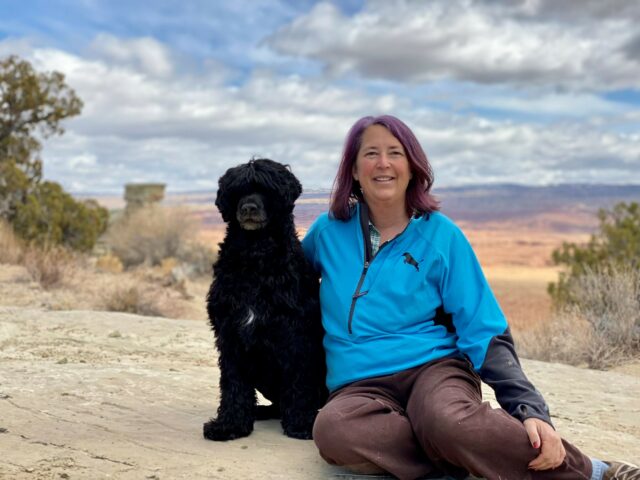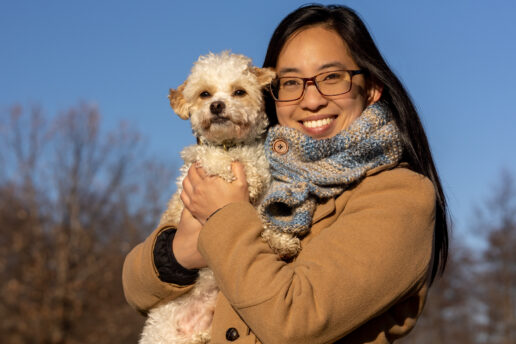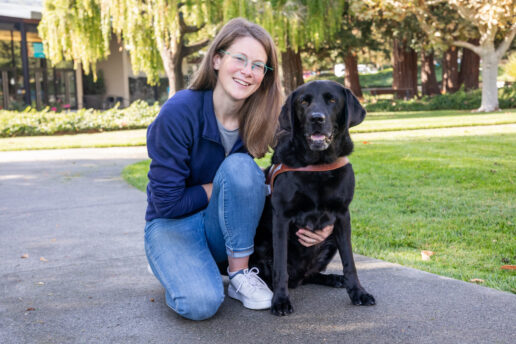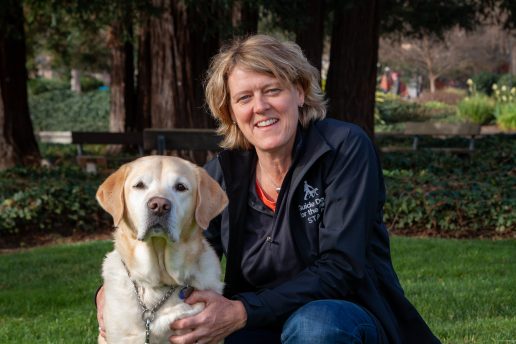
Central Bark Episode 9
Breeding the Next Generation of Guide Dogs
Each year, approximately 800 puppies are welcomed into the world at Guide Dogs for the Blind. In this special two-part episode, Theresa sits down with Jenna Bullis, the manager of GDB's world-renowned guide dog breeding program. Learn all about what makes a guide dog at the DNA level and the intricacies of managing the breeding population of dogs.
Theresa Stern: Today we have a really fascinating topic that we're going to discuss. We're going to learn about our industry leading breeding program at Guide Dogs for the Blind, as well as the team that's behind the scenes helping out with that program, and our international contributions to guide dog genetics. So we're really going to talk about guide dogs way down at the DNA level. So today we are joined by Jenna Bullis, one of my favorite people at Guide Dogs for the Blind. And she is the manager of breeding. Jenna, welcome to Central Bark.
Jenna Bullis: Thank you so much for having me Theresa. I'm super excited to be here and I'm really excited to talk about the topic that is near and dear to my heart, as you know, and share some breeding insights with everyone.
Theresa: Awesome. Now, you've had an interesting journey coming to Guide Dogs for the Blind. I know that your role has really evolved over the years. Can you tell everyone a little bit about your path to your new position?
Jenna: Sure, I'd be happy to. I am what I like to refer to as the ultimate dog nerd. So my background is in psychology with an emphasis in animal behavior. And when I graduated from college, certainly I was hoping for a dream job of working with animals. And in a roundabout way, I ended up finding Guide Dogs. I started in the kennels in a position that we now call a canine welfare training technician, so it's like an assistant in the kennels. And I worked my way up from there and I became an apprentice instructor and then a full qualified GDMI instructor. And then I was a senior instructor, a master instructor, and then I became a training supervisor for the first 14 years of my career. I'm celebrating 25 years here at Guide Dogs this summer.
Theresa: Oh, congratulations, congratulations.
Jenna: Thank you.
Theresa: Yeah, it's amazing. It goes by fast, doesn't it?
Jenna: Oh my gosh. It goes by so fast when you get to do something that you're so passionate about. I feel so lucky that I get to work somewhere that I enjoy coming to work every day, that I'm doing something that impacts people's lives in the positive way that it does, and that I just find really interesting and fulfilling. So I was in training for 14 years and during that time, I also do nerdy dog things outside of work. So I've been involved in showing breeding dogs in the AKC world, both in performance and confirmation. I started out with Rottweilers, had Rottweilers for many years and then changed to Portuguese Water Dogs. So I was always really interested in breeding and genetics.
And as an instructor, I noticed trends in the dogs that I was training. I would always look at who were their parents and notice similarities in behavior and appearance. Then I would go over and talk to the breeding manager at the time that I was an instructor and I would be like, "Oh, I'm training this dog and it's so and so's son." And I always like these dogs out of this these parents. So I really enjoyed all my conversations with her and found what she did really fascinating and just being colleagues and talking about that stuff. So when she retired in 2011, she nudged me and was like, "Hey, I'm retiring and this might be a good fit for you."
Theresa: So cool.
Jenna: And I was really excited. So I threw my hat in the ring and I was really stoked to be the person chosen to become the breeding manager. So then this whole other side of Guide Dogs opened up to me and I learned so much more about the genetics and breeding and all of the things that we need to take into consideration. I think it was a really great fit because I had so much experience of knowing what we are looking for temperamentally for our clients. And having that background really lent itself well to being in charge of the breeding population.
Theresa: That's what I was thinking with your background in training guide dogs, training clients for partnering with a guide dog, that I would think having that extra background would be super beneficial in the job that you do now. So what are you looking for in terms of... What traits really make up the ideal guide dog?
Jenna: That's a great question, Theresa. People wonder what is the ideal guide dog. And I always think it's really fun to share with people that there's not one ideal type of dog that makes an ideal guide. Because our clients come from all over the US and Canada, they live in different environments, they have different needs as far as their activities and what they use a dog for. So it's really important that there's a wide variety of dogs. But there are some things that really are consistent throughout every dog.
And I would say probably one of the most important things is the confidence. We need dogs that are confident to be out in the world and to face the challenges that they face with traffic and transportation and pet dogs in the world and just all of the things that dogs get faced with. And they need to be confident to perform their job in the face of distractions. And the other thing is the desire to do the job, we want to breed dogs that want to do this. And it's one of the reasons we use the breeds that we do because they want to work with people, they thrive on being with their people and pleasing them, and the dogs really enjoy the work also.
Theresa: So tell me a little bit about that. I was going to ask you, because I know you've bred and raised Rottweilers and bread and raised Portuguese Water Dogs, but of course here at Guide Dogs for the Blind, we're using Labrador and Golden Retrievers, why are those breeds... Is that fairly typical for a working dog? Is that what we're looking for? Do you think someday we'll have the Portuguese Water Dog-Rottweiler cross guiding me down the street?
Jenna: Good God, I hope not. That's funny. That would be quite a mixture of dogs. No, it's a great question, Theresa because I think that worldwide, Labrador Retrievers are one of the number one working breeds in the world. And there's a lot of reasons for that. That is not to say that individuals of any type of breed dog or mixed breeds can't provide great service, individuals can absolutely. And there are a lot of breeds that other people have trained, either self trained or other schools use. But the Labrador Retrievers worldwide are the most successful working dogs. I think part of that is because they are the right size. So there's some practical considerations of a dog being the right size, not too big that they're hard to fit on the plane with you and not too small that you can't really feel their movements as they're guiding you, so that nice mid-size. That double layer coat of the laboratory Retriever makes them adaptable to a lot of different climates. So they can do well in cold weather or hot weather.
And these dogs were bred to work with humans, being hunting retrieving dogs. So they want to work with people, they're confident, they want to do the job, they're adaptable and friendly with people. We certainly don't want our guide dogs in a position of making decisions of, should I be protecting my person or not? We want a dog that's just really accepting of everybody and everything in their world and confident as they do their work. And Labradors really fit that bill. And to an extent, Golden Retrievers have a lot of those traits as well. They bring a little bit more sensitivity to them as well and some fun loving in general, some fun entertaining traits as well. So that's really why we use the breeds that we use. And then, of course, we breed the Labs and the Goldens to create a cross of those two and bring the best of both worlds together.
Theresa: Awesome, awesome. Now, when you're, just a little bit about the science and how you go about figuring out this whole puzzle of which mom dog to put with which dad dog, I'm sure it's not just because, oh, that one's cute and that one's cute and wouldn't they be super cute if they had puppies together. I'm sure there's more to it than that. So can you tell us just a little bit about it? Because I think that it's really interesting the data that you keep on these animals.
Jenna: So we're incredibly fortunate in that our organization has invested the resources to have a very robust database record keeping system. And we have, really since the time that I started in 1997, we have incredibly detailed records on all of the dogs in our program, not just our breeding population dogs. So their health traits, behavior traits, reasons that they were successful or not successful as a working guide. So we've kept all this information and then we've built reports to give us output from that and to give us trends of which pedigrees and which lines of dogs tend to produce different traits. So I would say that one of the most important decisions that I make as the breeding manager is which dogs join the breeding population, whether you're included as a breeder or not is very important.
So for that decision, we're looking at the individual dog and their health traits. They need to be free from all the diseases and orthopedically healthy and have the right type of temperament and suitability to become a guide dog. And then once they pass all of the health and temperamental testing to be included in the breeding population, then we're looking at, okay, now, who matches up best with who? And that's where some of these reports really help us. So if I have a dog that comes in and we're looking at breeding and I'm looking to pick a dad dog for the mom, I can look at reports that talk about her and her mom and her aunts and her grandmothers and what dogs they've produced in their careers and look at behavioral and health trends. Then I can pick a male who has complimentary traits for her.
Theresa: That it probably makes sense. I've seen some of the pedigrees on the guide dogs that I've had over the years. And I always tease that I can trace their genetics, their history, their roots back further, many more generations than my own. It's fascinating to me, and I think the science is just amazing, that it can be so predictive. Although sometimes I imagine you get like, oh, well that didn't work or that was good, but...
Jenna: Absolutely. And we get asked a lot, why don't you just repeat the same breeding? And we really don't do that. And some of the reason is because we're always looking to mix up the combination of genes that we have in our population in new and different ways so that down the road, we have a new combination to work with in the breeding population. But the other thing that's funny is, you can have a breeding that has then produced really successful puppies and you can repeat that, and it might or might not turn out the same way as the first time. So for us, we're always looking at genetic diversity and trying to mix up our breeding combinations. And like I said, selecting complimentary traits.
We're really fortunate in that we early on invested in working with population genetics and working with the scientists at UC Davis and developing estimated breeding values. So we use that for a lot of traits that we know are inherited. So part of the puzzle for us too is knowing which health and behavioral traits are genetic and more highly inherited versus more influenced by the environment. So there are some things that I feel like the breeding team can have some control over and then there's a lot of things that are really about our puppy raising program and our training programs and how we raise and develop our dogs from the time they're born, that all comes together.
Theresa: Speaking of that, so you've got the puppy raisers, they have all of our dogs when they first start. And then while you're looking through your database and you see a dog that you might want to keep in the breeding population, then you wouldn't alter that dog. And then if they're chosen to become a distinguished breeder for Guide Dogs for the Blind, tell me a little bit about the amazing volunteers that welcome these dogs into their homes.
Jenna: Oh, I would love to. We have such terrific volunteers. And what's really fun in our department is that we have families that have been breeder custodian families for us and then their kids grow up and they become breeder custodian families. So we have generations of volunteers with our program, and it's really fun to have that long term connection with our volunteers. So the way it works is that all of our breeding population dogs live with families that live generally within 50 miles of the school. So we do make an exception, if a puppy raiser has raised the dog that's being included in the breeding population and they live up to 75 miles away and they want to fill that role and care for that dog during its breeding career, we will allow them to be a little bit further away.
Theresa: That makes sense.
Jenna: But in general, they're 50 miles from the school. And they live with families like a regular family pet, most of the time they're adored. I like to say they're walking billboards for us because these are the most well behaved, handsomest, cutest dogs that we have. And they're with these families and they go out into the community and a lot of times they're wearing their breeder bandana scarf. And they're out at the kids' baseball game or whatever and people are like, "Oh my gosh, that dog is so beautiful and it's so well behaved. Where did you get it?" And then people tell them this is a breeder for Guide Dogs for the Blind. So our breeder custodian families are ambassadors for our program and also a lot how we get new volunteers who want to fill that role because they're like, "How do I get involved in that?"
Theresa: They want one of those.
Jenna: Exactly. So while the dogs are actively part of our breeding population, they remain owned by Guide Dogs. We provide all of their medical care, they come see our staff veterinarians, they board here on our campus whenever their families are out of town or somewhere where they can't take the dog with them, and they come in and provide their services whenever they're needed. So that's for both the females and the males. When they come, and let's say a female is coming to have a litter of puppies, she'll be in season and she comes and stays on our campus through her fertile time. We select her pairing and she'll have a date and we'll do the breeding here on campus. Then when her fertile cycle is over, she goes home to her family and we assume that she's pregnant. But about 30 days later, she'll come in for a pregnancy ultrasound.
And it's very much like a human one, they take the little pictures and they check and see how many puppies are in there and see the little hearts beating. That will give the veterinarians an idea of what size litter that female is carrying. And we'll change her food rations based on how many puppies we predict she's going to have. Then she goes home and just hangs out with her family. So a it's a really important part of being a volunteer who's housing a pregnant female, you want to have an environment that's not stressful for her, that has plenty of love and attention, and meets her needs and just lets her have some gentle exercise and just keeps her happy up until she's about ready to have her puppies.
Theresa: So Jenna, tell us a little bit about how somebody can get involved and maybe get to have one of these amazing breeder dogs in their home.
Jenna: So the first step is putting in an application on our website. We take those applications and give people some basic information about the program and what the obligations are as a volunteer in that capacity. You have to be open to bringing the dog back and forth whenever they need to have a vet appointment or if their services are needed. So there's making the dog available for us when we need the dog available for us. There's some pretty strict guidelines about where the dogs can go. We don't allow our breeding population dogs to visit dog parks because we feel like those might not be safe for our dogs from a standpoint of when you're reproductive intact, other dogs may treat you differently. And we want to keep our dogs safe, they always have to remain on leash. So this is not a dog that you can take out hiking in the hills and cut them off leash. We want to keep our dogs safe and healthy.
So as long as that fits in with somebody's lifestyle, then they can apply for the dog. And we do a really rigorous application process of they get a phone interview with the breeding staff team and we talk about the program and how it works and answer any questions they might have, get some information about their home and their lifestyle and what their expectations are for the dog. We do a home visit to make sure that all the fences are in good repair and that the dogs aren't going to escape and that kind of thing. Then they go on a wait list until the right match. And it's really like the matching process that we do for our clients. So we think about when we place the breeder dog in a family home that we're making a placement for life. While it's not required that our volunteers adopt the dogs at the end of their career, 99% of them do that.
And we want a dog that fits in with their family and their lifestyle and that the dog is going to be happy and the people are going to be happy together. So we're really careful about matching the right dog to the right family as far as energy level and any other types of traits that are needed to be considered. Then the team in the breeding department provides support for that volunteer family through the career of that dog. So if they have... Sometimes a dog will go home and they've had very great upbringing from their puppy raisers and the dog decides, I wonder if the rules apply in my new home. And maybe they'll start trying to get in the garbage can or up on the counter to get food. So our volunteers would call our team and say, "Hey, I'm having a little trouble with this." So we coach them through like, okay, here's how you can manage this behavior. Again, it's all trying to make a happy placement that's smooth and enjoyable for all parties. So we provide support to our custodial families in that way.
Theresa: That's awesome. Such a great program.
Jenna: So after our volunteers have applied and gone through the phone screening process and the home check, we also provide a training class, we call it the dog management class. So one of the staff here in the breeding department does a half day class with our families to talk about general dog care and care that's specific to a reproductive intact dog, which can be a little bit different from a dog who is neutered. And how to manage the dog, how you bring a new dog into your home and set up appropriate health behavior and that kind of thing. So they get off to a really good start. After we provide all that training and get to know the families a little bit more and what dog would fit into their lives, then we'll do that placement and provide all the after support.
We also have a 30 day well check. So after the dog has lived in their new home for the first 30 days, they come in and do just a check in. We get a weight on the dog and see if the amount of food that they're eating in the home versus the kennel is the right amount, we do a little nail trim, talk about how it's going, how's all the behavior going. And it's just a nice opportunity for us to check in that first month to make sure everything's going smoothly while establishing habits and patterns that the dogs are going to have for the rest of their lives in that home.
Theresa: That is just such a fantastic, amazing program. Jenna, there's so much to talk about. I hope everybody can join us next time, we're going to continue talking about Guide Dogs for the Blind's amazing breeding program. For more information about Guide Dogs for the Blind, please visit guidedogs.com.
Related Episodes



